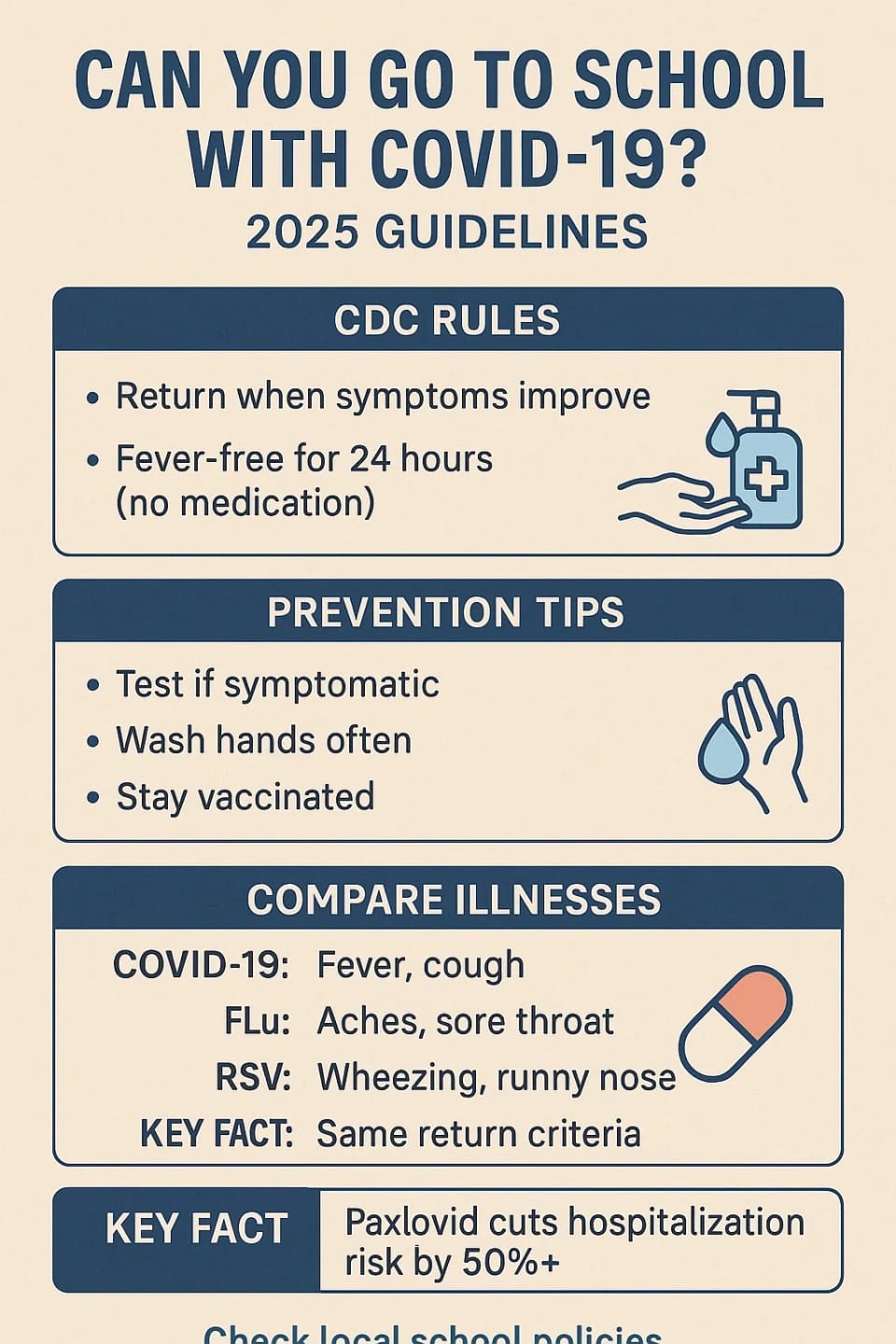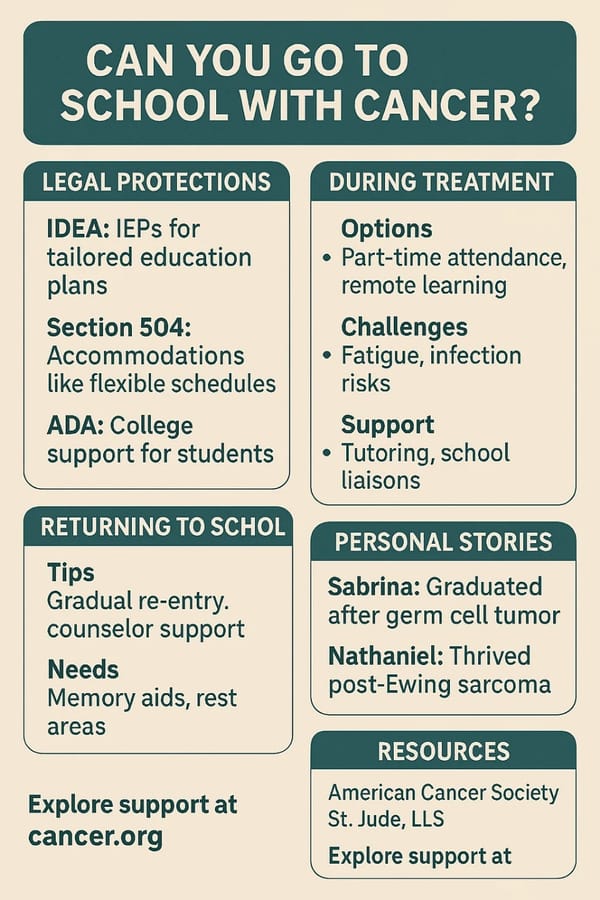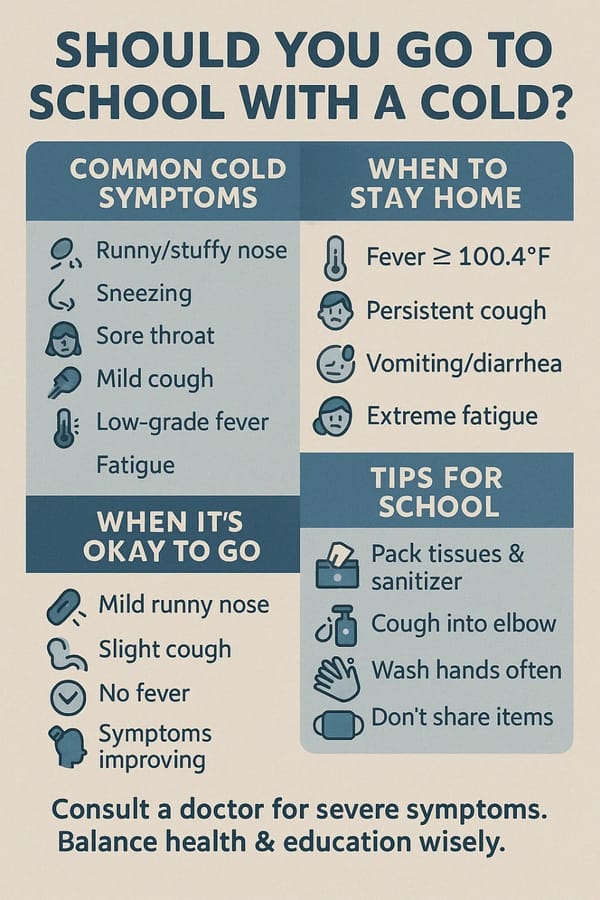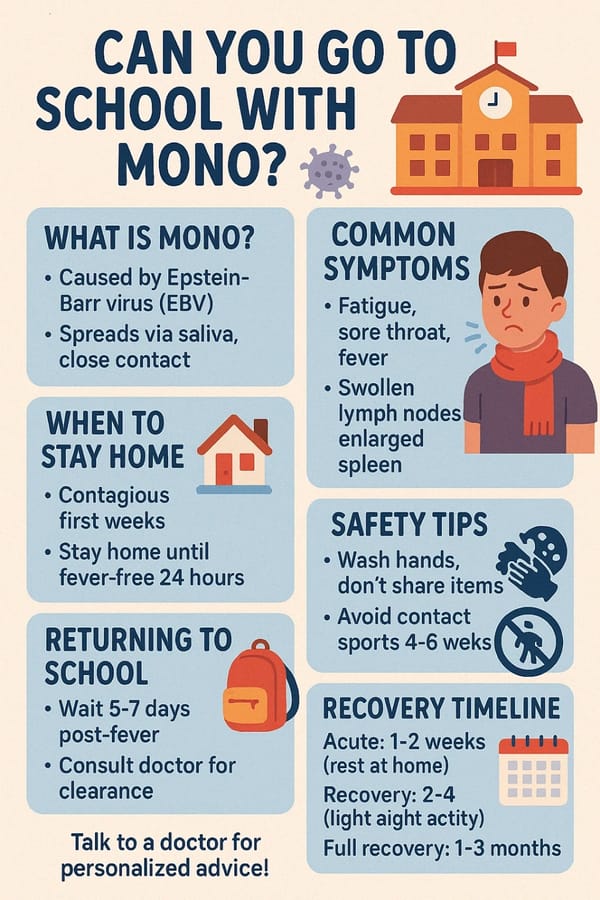Can You Go to School with COVID-19? A Comprehensive Guide for Parents and Educators
Since April 15, 2025, parents, students, and educators continue to prioritize the question of whether individuals with COVID-19 can attend school while navigating public health developments. Since COVID-19 is now treated like typical respiratory viruses such as influenza or RSV we must understand the guidelines to maintain educational safety. Read this article to learn about current policies alongside practical advice and personal experiences which will guide you to make informed choices. This resource offers definitive guidance to parents considering their child's school attendance and teachers seeking to maintain a healthy classroom environment.
Why This Matters: The Intersection of Health and Learning
Years of advancement in vaccines and treatments along with widespread immunity have diminished COVID-19 severity for most people as evidenced by the current management shift. Schools face significant challenges because illnesses can spread rapidly through close contact between students. Students who miss classes face learning disruptions but those who return too early endanger the health of their peers. Federal guidelines now support adaptable approaches while local rules differ so understanding all details becomes crucial. This resource examines safety protocols while presenting actual experiences and strategies to ensure schools remain secure and educational engagement continues.
Current Guidelines: When Can Students Return to School?
Federal Recommendations from the CDC
The Centers for Disease Control and Prevention (CDC) provides explicit instructions for 2025 stating students with COVID-19 can return to school once their symptoms show general improvement and they remain without fever for a minimum of 24 hours without the aid of fever-reducing drugs[1]. The protocols for COVID-19 mirror established procedures for different respiratory viruses indicating a consistent treatment strategy for illnesses such as influenza and respiratory syncytial virus (RSV). School policies now prioritize ending symptoms before returning to classes rather than requiring students to stay isolated as they did in the previous pandemic years.
The End of Vaccine Mandates
A significant policy shift came in February 2025, when the White House proclamation ended COVID-19 vaccine mandates in schools[2]. The policy shift prioritizes parental decision-making power while recognizing that children face minimal risk for serious COVID-19 complications. The decision doesn't establish attendance rules but indicates a movement toward more flexible health policies which increases family involvement in medical choices.
Local Variations to Watch For
Local health departments and school districts might implement rules stricter than federal guidelines. During outbreaks certain regions enforce requirements for negative testing or additional isolation periods. Schools should obtain specific guidance by consulting local health authorities and their emergency operations plans (EOPs)[1:1]. Contact your local health department and visit your school’s website to ensure compliance with health regulations.
COVID-19 in 2025: A Broader Context
A New Normal for Respiratory Illnesses
COVID-19 joins flu and RSV as a seasonal respiratory illness by 2025. The CDC’s Respiratory Virus Guidance lists essential prevention methods which include vaccination, hygiene practices, and indoor air quality enhancement[3]. The measures target prevention of all respiratory viruses while building a comprehensive school health strategy beyond COVID-19.
Trends and Predictions
The 2025 respiratory season is expected to show equal or fewer hospitalization rates than past seasons because of immunity development and Paxlovid treatment options[4]. Paxlovid demonstrates its effectiveness by cutting hospitalization chances by more than half and reducing deaths even further to protect vulnerable populations. This stability enables schools to concentrate on preventive measures to maintain classroom accessibility.
Personal Stories: Real Families, Real Decisions
The process of managing COVID-19 extends beyond official regulations to encompass personal decision-making in everyday life. Take Sarah, a parent from Ohio: After my daughter tested positive for COVID-19 last autumn my spouse and I kept her at home until her cough stopped and she remained fever-free for a full day. Managing schoolwork presented challenges but teachers sending assignments online provided assistance.
Educators share similar insights. A middle school teacher named Mr. Thompson reports that his school experienced several COVID-19 cases this year. Parents generally keep their children at home for several days while we coordinate together to prevent academic setbacks.
Practical Tips for Parents and Educators
Managing COVID-19 in schools requires teamwork. These strategies provide actionable steps to maintain safety and continuity.
- Rapid testing should be used to confirm COVID-19 in children who develop fever or cough symptoms following exposure to the virus. The CDC recommends testing to guide decisions about staying home[5].
- Educate children to practice regular handwashing along with using tissues for coughs to maintain proper hygiene. Schools should provide sanitizer supplies in each classroom while encouraging proper sanitary habits.
- Reach out to the school with information about your sick child and understand their procedures for returning to school. Schools need to distribute policy revisions immediately to prevent misunderstandings.
- Missing school due to illness can cause mental stress in children. Offer reassurance and maintain routines. Absent students can receive counseling services or school check-ins if their institution offers the program.
- Vaccines continue to serve as the primary defense against serious health complications. Ensure your family is up to date, as the CDC notes that unvaccinated individuals face higher risks[6].
Vaccines and Treatments: Your Safety Toolkit
Vaccines are a cornerstone of COVID-19 prevention. The CDC recommends maintaining up-to-date immunizations plus booster shots for eligible children to reduce serious illness risks[3:1]. Hospitalization records from 2023 indicate that more than 95% of adult patients were not current with their vaccinations which underscores the importance of vaccination.
Treatments such as Paxlovid can help people with COVID-19 recover more effectively, particularly those who face higher health risks. The objective extends beyond recovery as vaccination ensures reduced risk of serious complications. Consult a doctor to determine the best options for your child if they suffer from asthma.
Comparing COVID-19 to Other Illnesses
This comparison outlines how COVID-19 relates to school health by examining similarities and differences with flu and RSV.
| Illness | Symptoms | Return to School | Vaccination |
|---|---|---|---|
| COVID-19 | Fever, cough, fatigue | Symptoms improving, fever-free 24 hours | Yes, for all ages |
| Influenza | Fever, aches, sore throat | Symptoms improving, fever-free 24 hours | Yes, annual shot |
| RSV | Runny nose, cough, wheezing | Symptoms improving, fever-free 24 hours | Yes, infants and older adults |
The table illustrates management overlaps which demonstrate that COVID-19 treatment in schools now resembles standard procedures for common illnesses.
Addressing Common Concerns
What If My School Has Different Rules?
Federal guidelines may not always hold because local policies tend to differ. During COVID-19 surges certain districts might enforce mask mandates and extend isolation periods. Get in touch with your school administration to understand their policies and push for open communication.
How Do I Help My Child Catch Up?
When your child misses school days it's important to coordinate with educators to retrieve their assignments. Schools provide online platforms and tutoring services to help students overcome learning challenges. Keep your child involved for short periods to sustain their academic progress.
Is It Safe to Return?
The CDC indicates that students can safely return to school after their symptoms subside and they experience no fever for 24 hours[1:2]. Implementing proper ventilation systems together with maintaining hygiene practices decreases risks and brings classroom safety to new heights.
Conclusion: Empowering Choices for a Healthy School Year
In 2025, attending school with COVID-19 rests on straightforward criteria: your child must show recovery signs and remain fever-free for 24 hours without medication. Federal guidelines, reinforced by the end of vaccine mandates, emphasize flexibility and parental authority, though local regulations may introduce specifics[2:1]. By staying informed, collaborating with schools, and using tools like vaccines and testing, families can navigate these rules confidently.
COVID-19 is now a manageable part of seasonal illnesses, controlled through teamwork and practical steps. Whether you’re a parent protecting your child’s health or an educator fostering a safe classroom, this guide equips you to make decisions that prioritize learning. Have questions or insights to share? Leave a comment below or review your school’s policies to stay proactive!
CDC Guidelines for When Students or Staff are Sick
These guidelines specify how schools should handle cases when students or staff show signs of illness. ↩︎ ↩︎ ↩︎White House Proclamation on Ending COVID-19 Vaccine Mandates
The White House has issued a proclamation to end COVID-19 vaccine requirements in schools and ensure educational access. ↩︎ ↩︎CDC Respiratory Virus Guidance
Outlines prevention strategies for all respiratory viruses, including COVID-19. ↩︎ ↩︎2024-2025 Respiratory Disease Season Outlook
Projections for hospitalization trends in 2025. ↩︎CDC Prevention Strategies for COVID-19
Testing and hygiene recommendations. ↩︎Respiratory Virus Guidance Update FAQs
Data on vaccines and treatments like Paxlovid. ↩︎






